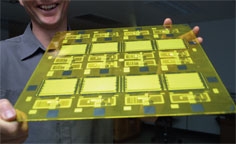Cambridge University’s Cavendish Professorship, its most senior physics role, has an illustrious history; the first Cavendish Professor was the father of electromagnetic theory, James Clark Maxwell. The current incumbent, Richard Friend, likes to quote Maxwell’s inaugural lecture in 1873; he started his speech by saying: ’It is generally considered that there is nothing left to do in physics.’ But prediction, Friend says, ’is by definition something that you usually get wrong’.

Friend, who was knighted for services to physics in 2003, is perhaps best known for his pivotal role in developing plastic electronics, a technology that is about to hit the market in a big way and which has earned him a nomination for the biennial Millennium Technology Prize. Well suited to distributing electronic components over a wide area without the need for high temperatures and extreme vacuums of conventional electronics, plastic semiconductors are ideal for making display screens. Lightweight, potentially flexible and much less fragile than glass, such screens will be on sale in products such as e-readers by the end of this year.
However, Friend said, the key breakthrough for this application - the development of a polymer LED - was made almost by accident. ’Back in the mid-1980s, I’d set out to get a programme of work going to see if we could make regular semiconductor devices out of these strange and wonderful carbon-based semiconductors based on polyacetylene,’ he said. ’We succeeded in making transistors, and then in 1989 we were trying to make diodes. The top electrode on the structure was a film of aluminium, thin enough to be partially transparent. We put a voltage onto the structure that we thought would induce breakdown, but my student Jeremy Burroughes - who had actually built those original transistors - noticed that light was coming out of it.’
Polymer electronics work by manipulating the way that carbon bonds to itself; in certain types of unsaturated molecules, and in graphite and graphene, a certain amount of electrons are bound to the molecule but free to move around its structure, rather than being associated with only one atom in the molecule. This is similar to the ’electron and hole’ pairs in a conventional semiconductor such as silicon, although there are differences in the physics.
One of the strengths of this work is that we’ve managed to run the science and the engineering together. We’ve had a two-way trade of knowledge and patent applications, with new technology coming back into the Cavendish Laboratory.
An advantage of plastic electronics technology is that it can be manufactured using solutions at room temperature, using processes similar to printing. ’For transistors, the best of the solution-based organics are now better-performing than amorphous silicon, which is what’s used for LCD panels,’ Friend said. ’They aren’t quite as good as crystalline silicon, but they do look pretty good for display technology.’
This is a matching of the capabilities of the material to the demands of the application in terms of the plastic components’ functionality, but the room-temperature processing has other advantages. He said: ’You want to be able to put transistors down over a large area, and being able to do that at low temperature means you don’t have to deposit them on sheets of glass, as you do with silicon-based electronics. You can use plastic and that gives you a performance advantage, as well as a manufacturing advantage - you’ve made something that isn’t breakable and is to some degree flexible, and you’ve probably made it cheaper as well.’

Cavendish Professor of Physics Cambridge University
Education
- 1974 BA in theoretical physics, Cambridge University
- 1978 PhD from the Cavendish Laboratory
- 1979 Research Fellowship, St John’s College
Career
- 1977-1994 Research and teaching positions at institutions including Université Paris-Sud, returning to Cambridge in 1980
- 1995 Cavendish Professor of Physics
- 1996 Chief scientist, Cambridge Display Technology
- 2000 Chief scientist, Plastic Logic
Honours
- 1993 Fellow of Royal Society of London
- 2002 McRobert Prize from Royal Academy of Engineering for work with Cambridge Display Technology
- 2002 Fellow of Royal Academy of Engineering
- 2003 Faraday Medal of Royal Society of Engineers
- 2003 Awarded knighthood
Q&A Proving grounds
Many people say interdisciplinarity is the key to success in the UK. Would you agree?
The university departments here have been slow to intermingle; slower than I’ve seen in the best universities in the US. But I think that the UK is a place where young academics can take bigger risks and still get tenure. In the US, you can’t take risks; your projects have to work within a year, so in five years your application record is stunning. We give people longer to prove themselves in the UK; the pressures are different, and you can look longer term.
How can we encourage young scientists and engineers in the UK?
The key has to be that there is a proper career structure for the best and the brightest. It’s very easy to see how to get a job and how to get on in, say, management consultancy or investment banking, but it’s very difficult to see what a long-term career in engineering might look like.
Could a lack of entrepreneurship be what’s missing?
There is certainly a gap between what we do very well at universities and manufacturing companies - such as they are - picking that up. But that isn’t the whole picture. If you compare how we are here with Germany, for example, you can see that success in engineering is a result of many years of hard slog. You need to have the foundations in place; you need to have competence over a broad range of skills, and then you can move fast from labs into commercial applications and into the market. I just don’t think that being entrepreneurial is enough if you don’t have that good base. I believe we do need to build up those skills here.
Why do you think we lost those skills?
We unbalanced our economy when we closed down what were in effect our national laboratories: the defence labs, the Central Electricity Generating Board labs, the British Telecom labs. Those were places where technology got done. In some sense, closing them was an efficiency saving, but it took something out of the system. The small companies that have replaced them in the sector cannot handle the level of longer-term commitment that the corporates used to be able to do.




Nanogenerator consumes CO2 to generate electricity
Whoopee, they've solved how to keep a light on but not a lot else.